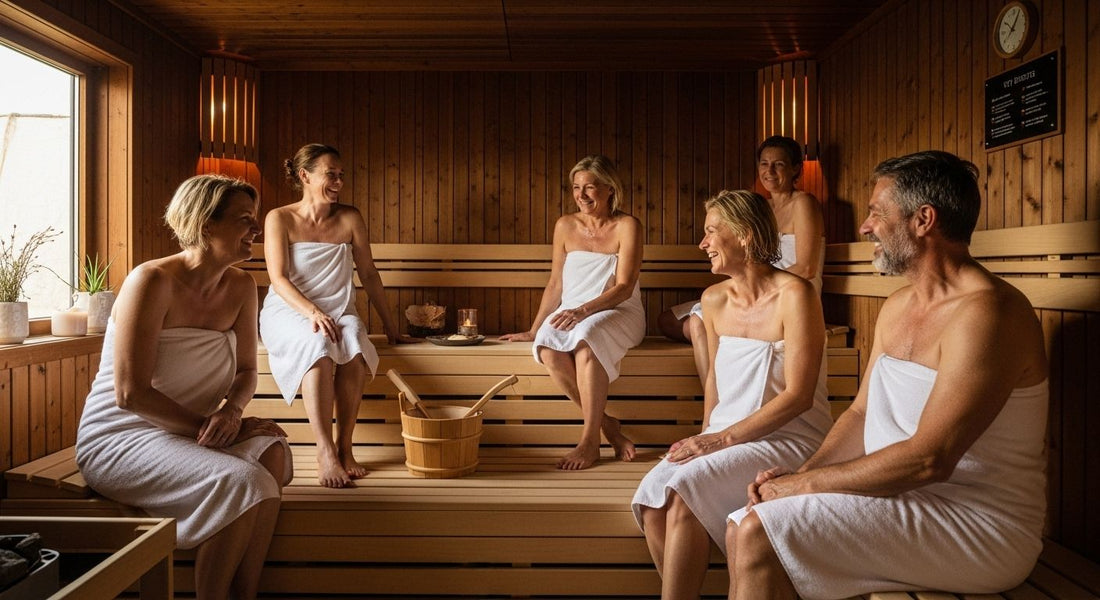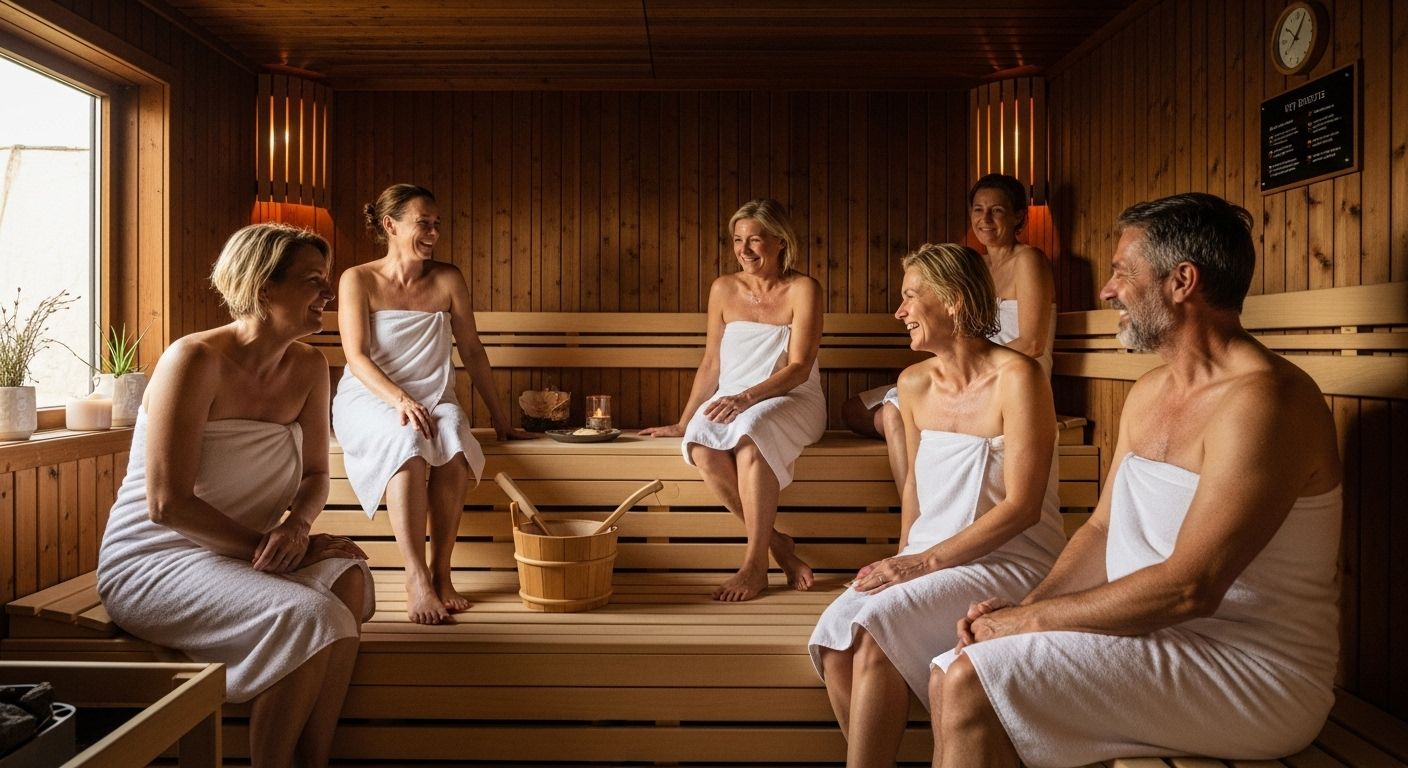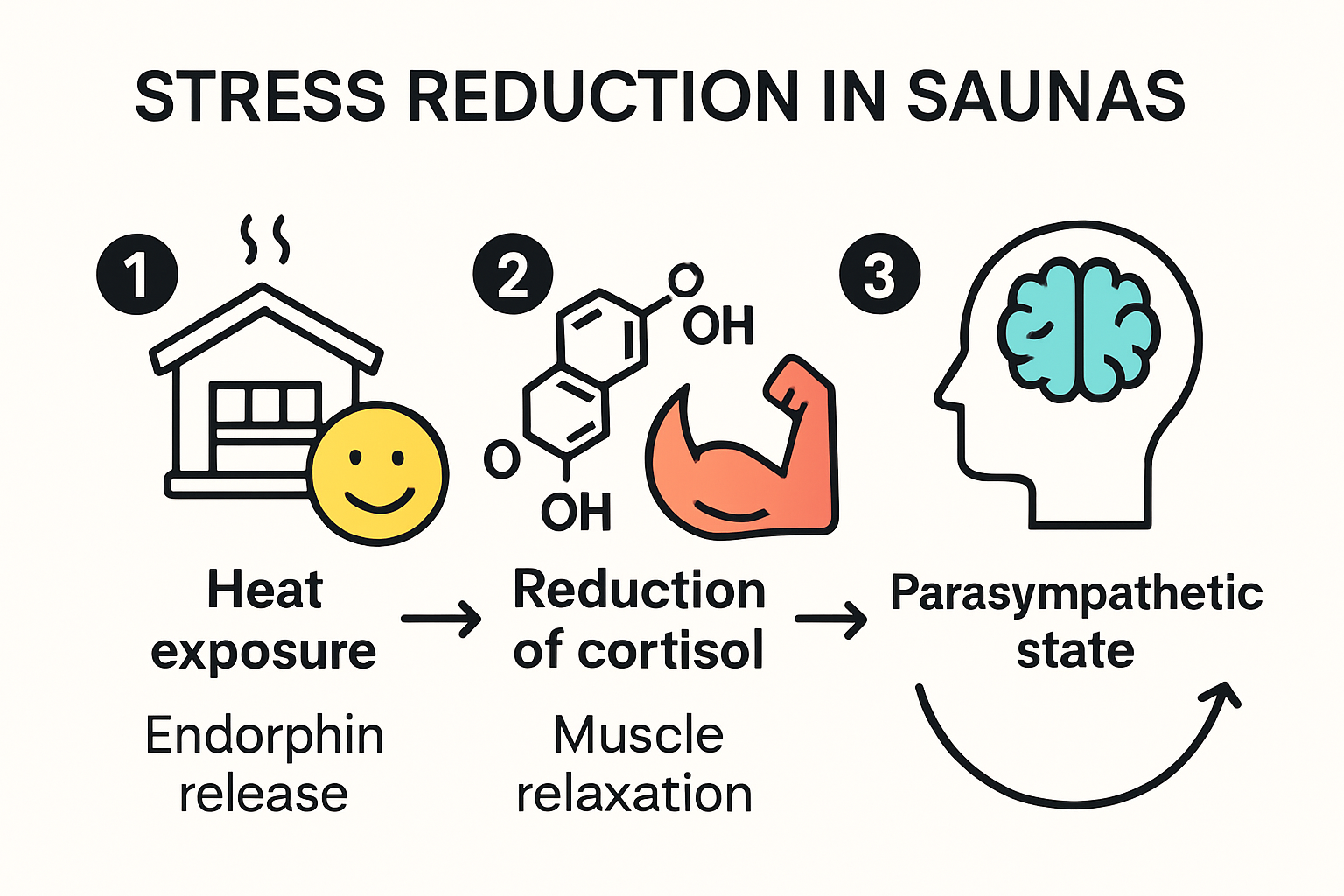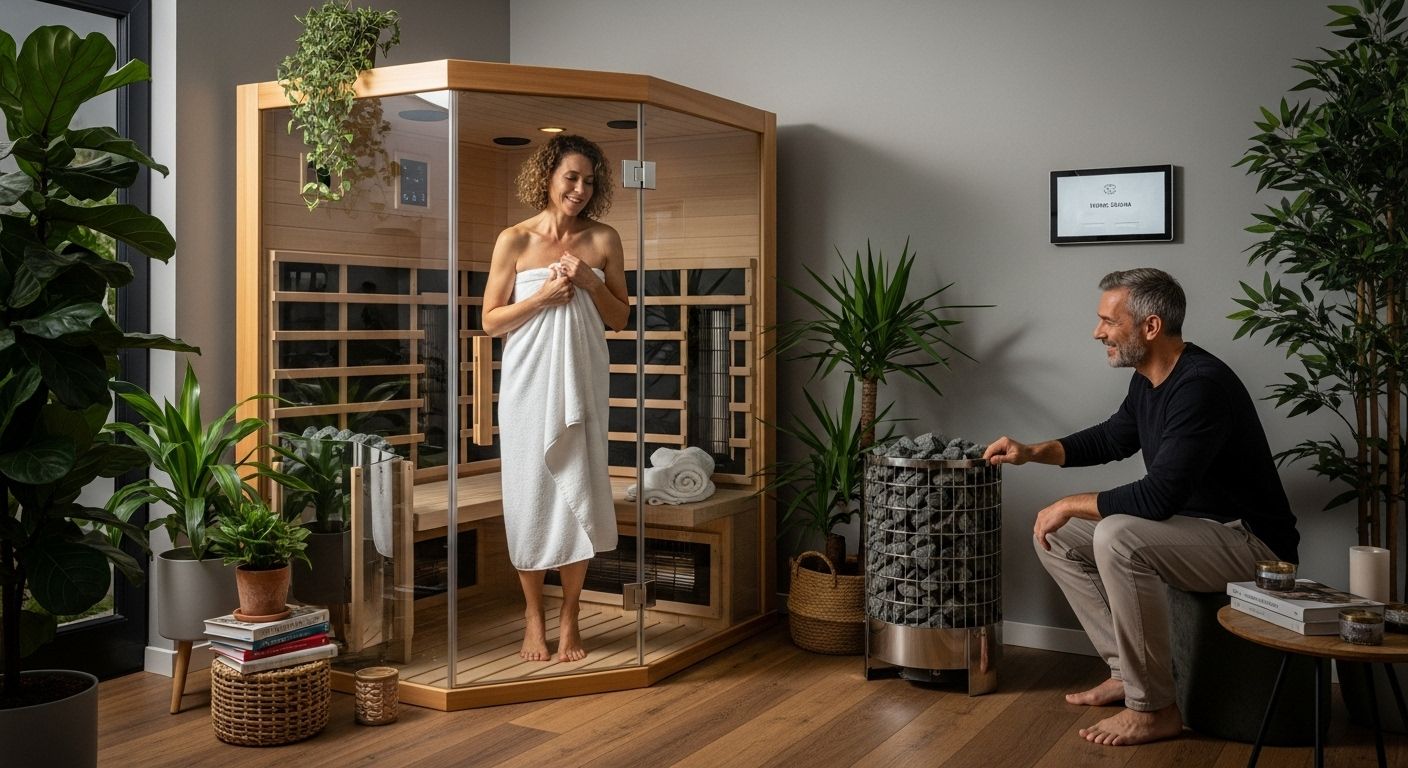
Why Do People Enjoy Saunas? Key Benefits in 2025

Saunas are popping up everywhere, from luxury gyms in New York to backyards in Minnesota. But most people just think of them as steamy rooms for sweating and relaxing. Turns out, spending regular time in a sauna can actually lower your risk of dying from heart problems by as much as 40 percent according to Mayo Clinic research. The real surprise is how these ancient traditions are now backed by cutting-edge science, making that weekly sauna session a powerful tool for both your body and your mind.
Table of Contents
- The Appeal Of Sauna Tradition And Culture
- Health Benefits For Mind And Body
- Saunas For Relaxation And Stress Relief
- Choosing The Right Sauna Experience At Home
Quick Summary
| Takeaway | Explanation |
|---|---|
| Saunas foster social connections. | Saunas provide communal spaces that break social barriers, promoting deep bonds through shared experiences. |
| Regular use boosts cardiovascular health. | Consistent sauna sessions enhance vascular function, reduce heart disease risks, and act as a passive exercise. |
| Heat exposure supports mental well-being. | Sauna sessions help reduce stress and anxiety by promoting relaxation and emotional regulation through endorphin release. |
| Saunas enhance recovery and immunity. | The heat stimulates metabolic processes that aid detoxification and boost immune responses, improving overall health. |
| Home saunas require thoughtful planning. | Choose the right type, consider installation needs, and maintain regularly for an optimal personal wellness sanctuary. |
The Appeal of Sauna Tradition and Culture
Sauna culture represents far more than a simple wellness practice. It is a profound social ritual that connects people across generations and cultures, transforming a seemingly simple heat experience into a deeply meaningful human interaction.
A Sacred Space of Connection
In Finland, saunas transcend mere physical cleansing. UNESCO recognizes sauna culture as an intangible cultural heritage, describing it as a “sacred space of nature” where individuals do more than wash their bodies they cleanse their minds and spirits. This perspective reveals saunas as powerful communal environments that foster deep social bonds.
Traditionally, saunas have been spaces of remarkable egalitarianism. People from all social backgrounds gather in these warm chambers, breaking down social barriers and creating genuine human connections. Research from Simon Fraser University highlights how public saunas serve as critical social infrastructure, combating urban isolation by providing a unique environment for meaningful interactions.
Cultural Ritual Beyond Wellness
The sauna experience goes far beyond physical health benefits. In regions like Minnesota, saunas represent a cultural touchstone that helps communities navigate challenging environments. Associated Press reporting reveals how these spaces became even more significant during the COVID-19 pandemic, offering people a sense of connection and shared experience during periods of social distancing.
In Finnish tradition, saunas are not just rooms but sacred spaces where storytelling, healing, and community building occur simultaneously. Volunteers often build and maintain public saunas, demonstrating a collective commitment to preserving this rich cultural practice. The ritual involves much more than sweating it represents a holistic approach to human wellbeing that integrates physical, mental, and social dimensions.
Global Cultural Exchange
As wellness trends spread globally, sauna culture has become a fascinating example of cultural exchange. What began as a deeply regional practice in Nordic countries has transformed into a worldwide phenomenon. People are increasingly recognizing that saunas offer more than temperature extremes they provide a unique environment for human connection, stress relief, and personal reflection.
The appeal of sauna tradition lies not just in its physical benefits but in its ability to create shared human experiences. Whether in a traditional Finnish smoke sauna or a modern infrared facility, these spaces invite people to slow down, disconnect from digital distractions, and reconnect with themselves and others in a profoundly intimate setting.
Health Benefits for Mind and Body
Saunas offer a powerful approach to holistic wellness, providing comprehensive benefits that extend far beyond simple heat exposure. By engaging multiple physiological systems simultaneously, sauna sessions create a transformative experience for both mental and physical health.
Cardiovascular Wellness and Physiological Resilience
Research published in Mayo Clinic Proceedings reveals compelling evidence about the cardiovascular advantages of regular sauna use. The study demonstrates that consistent sauna bathing significantly reduces risks associated with heart disease, high blood pressure, and stroke. The intense heat exposure triggers a cascade of beneficial physiological responses, including improved vascular function and enhanced blood circulation.
When the body experiences controlled heat stress, blood vessels dilate, promoting more efficient blood flow. This process mimics cardiovascular exercise, providing similar benefits without the physical exertion. The body responds by increasing heart rate and improving overall cardiovascular performance, essentially offering a passive workout that supports long-term heart health.
Neurological and Mental Health Optimization
Stanford University’s Lifestyle Medicine program uncovered fascinating connections between sauna use and cognitive function. The research indicates that frequent heat exposure increases brain-derived neurotrophic factor (BDNF), a critical protein supporting neuronal development and cognitive performance. This mechanism suggests potential protective effects against age-related cognitive decline and neurodegenerative conditions.
The Cleveland Clinic further emphasizes the mental health benefits, highlighting how sauna sessions promote profound relaxation. The heat-induced stress reduction mechanism triggers the release of endorphins and reduces cortisol levels, creating a natural pathway to improved emotional regulation and reduced anxiety.
Holistic Recovery and Immune System Support
Beyond cardiovascular and neurological benefits, saunas offer comprehensive recovery support for the body. The intense heat stimulates metabolic processes, encouraging sweating that helps eliminate toxins and supports immune system function. Increased core body temperature mimics fever responses, potentially activating immune cells and enhancing the body’s natural defense mechanisms.
The combination of heat stress and subsequent cooling creates a powerful physiological adaptation process. This cycle challenges the body’s systems, promoting resilience and improving overall metabolic efficiency. Regular sauna users often report enhanced energy levels, improved sleep quality, and a more robust sense of physical and mental well-being.
Ultimately, sauna sessions represent more than a wellness trend. They are a scientifically validated approach to holistic health, offering a multifaceted intervention that supports cardiovascular, neurological, and immunological systems through a single, enjoyable experience.
Saunas for Relaxation and Stress Relief
In our fast-paced modern world, finding effective stress relief strategies has become increasingly crucial. Saunas emerge as a powerful sanctuary for individuals seeking comprehensive relaxation and mental reset, offering a holistic approach to managing stress and promoting psychological well-being.
The Physiological Mechanism of Stress Reduction
Research published in Evidence-Based Complementary and Alternative Medicine provides fascinating insights into how sauna sessions trigger profound stress reduction mechanisms. The heat exposure initiates a complex physiological response that directly impacts the body’s stress management systems. When subjected to controlled heat, the body releases endorphins and reduces cortisol levels, creating a natural biochemical pathway to relaxation.

The warm environment acts as a physical and psychological buffer against daily stressors. As body temperature rises, muscles naturally relax, tension dissipates, and the nervous system shifts from a heightened sympathetic state to a more balanced parasympathetic mode. This transition represents a critical moment of physiological recalibration, allowing individuals to experience deep, meaningful relaxation.
Mental Reset and Emotional Resilience
Saunas provide more than physical warmth they offer a meditative space removed from external stimuli. The enclosed, quiet environment encourages mindfulness and introspection. Users report experiencing a unique form of mental clarity that emerges when disconnected from digital devices and daily pressures. The heat acts as a sensory cocoon, allowing individuals to process emotions, reset mental frameworks, and develop greater emotional resilience.
The intentional discomfort of heat exposure also serves as a controlled stress experience. By voluntarily experiencing and managing physical intensity, sauna users develop psychological strategies for handling stress. This metaphorical training ground helps build mental toughness and adaptive coping mechanisms that extend beyond the sauna environment.
Holistic Stress Management Approach
Unlike pharmaceutical interventions or temporary relaxation techniques, saunas offer a comprehensive stress management solution. The combination of heat, isolation, and bodily response creates a multisensory experience that addresses stress from multiple angles. Improved circulation, muscle relaxation, hormone regulation, and mental recalibration work synergistically to combat the negative impacts of chronic stress.
Regular sauna practice becomes a proactive wellness strategy. By scheduling consistent sessions, individuals establish a ritual of self-care that signals to both body and mind a commitment to personal well-being. The predictability and intentionality of these sessions contribute to long-term stress resilience, helping users develop a more balanced approach to life’s challenges.
In essence, saunas transcend simple heat therapy. They represent a sophisticated, scientifically-supported approach to holistic stress management that honors the intricate connection between physical experience and psychological well-being.
Choosing the Right Sauna Experience at Home
Creating a personalized sauna experience at home requires thoughtful consideration of individual wellness goals, available space, and specific health needs. Understanding the nuanced differences between sauna types can help individuals make informed decisions that maximize health benefits and personal comfort.
Types of Home Sauna Technologies
Below is a comparison of the two primary home sauna types discussed, highlighting their key features and differences:
| Sauna Type | Heating Method | Temperature Range | Notable Benefits |
|---|---|---|---|
| Traditional Sauna | Wood-burning/Electric heaters | 150-195°F | Classic intense heat, robust thermal experience, strong physiological response |
| Infrared Sauna | Electromagnetic infrared waves | Gentler, typically 120-150°F | Direct tissue heating, unique metabolic benefits, suitable for gentler exposure |
Both types offer health and wellness benefits, but the experience and heat intensity differ.
Health Considerations and Frequency
To help you plan your home sauna setup, here is a checklist table summarizing key factors to consider as described in the content:
| Consideration | Importance/Action |
|---|---|
| Available Space | Measure carefully to ensure proper fit |
| Power Requirements | Confirm electrical compatibility with sauna system |
| Budget | Evaluate both immediate and long-term investment |
| Personal Health Goals | Match sauna type and frequency to wellness objectives |
Health Considerations and Frequency
Mayo Clinic Proceedings research emphasizes the importance of consistent sauna use for maximizing cardiovascular benefits. The study indicates that regular sessions can improve endothelial function and reduce arterial stiffness. A prospective cohort study further recommends frequency as a critical factor, suggesting that individuals who use saunas more than four times per week experience significantly lower cardiovascular mortality risks.
When selecting a home sauna, consider factors such as:
- Available Space: Measure your designated area carefully
- Power Requirements: Confirm electrical compatibility
- Budget: Evaluate long-term investment versus immediate costs
- Personal Health Goals: Match sauna type to specific wellness objectives
Installation and Maintenance Strategies
Successful home sauna integration involves more than technological selection. Proper installation requires understanding ventilation, electrical requirements, and potential structural modifications. Consulting with professional installers can help navigate these technical considerations.
Maintenance represents another crucial aspect of home sauna ownership. Regular cleaning, wood treatment for traditional saunas, and electrical system checks ensure longevity and optimal performance. Users should develop a consistent maintenance routine that preserves the sauna’s functionality and hygiene.
Beyond technical specifications, the ideal home sauna creates a personal wellness sanctuary. It should reflect individual preferences while providing a consistent, comfortable environment for health optimization. Whether seeking stress reduction, cardiovascular support, or metabolic enhancement, the right home sauna can transform personal wellness practices.

Frequently Asked Questions
What are the health benefits of using a sauna?
Regular sauna use offers several health benefits, including improved cardiovascular health, enhanced mental well-being, and better immune support. Research indicates that consistent sauna sessions can lower the risk of heart disease and promote relaxation through heat-induced endorphin release.
How often should I use a sauna for optimal benefits?
To gain the maximum cardiovascular and health benefits, it’s recommended to use a sauna at least four times a week. Studies suggest that frequent use significantly reduces the risk of cardiovascular mortality and enhances overall health.
What are the differences between traditional and infrared saunas?
Traditional saunas use wood-burning or electric heaters to create intense heat (150-195°F), providing a robust thermal experience. Infrared saunas utilize electromagnetic waves for gentler heating (120-150°F) that directly warms the body, offering unique metabolic benefits while being more suitable for lower heat exposure.
How does sauna use contribute to stress relief?
Sauna sessions promote stress relief by triggering physiological responses that lower cortisol levels and release endorphins, helping the body transition to a relaxed state. The warm environment also encourages mindfulness and introspection, making it a powerful tool for holistic stress management.
Bring the Benefits of Saunas Home with Best Life Sauna
You have read about how saunas create real change for your body and mind, from lowering stress levels and boosting your heart health to promoting deeper social connections. Maybe you are eager to experience these health benefits in your own space, but struggle to find a reliable solution that fits your lifestyle and offers true long-term value. Or perhaps you want a sanctuary for relaxation, better recovery, or to simply disconnect from everyday pressures. Choosing the right sauna experience should be easy and enjoyable.

Let Best Life Sauna help you transform your wellness routine. Our premium sauna collection brings all the science-backed benefits discussed in the article right to your home. Discover world-class infrared and traditional saunas, outdoor options, and unique wellness upgrades. With exclusive offers like free shipping on qualifying orders and a price match guarantee, now is the perfect moment to start your journey to greater relaxation and health. Explore solutions confidently at Best Life Sauna and take the next step toward a better you.

